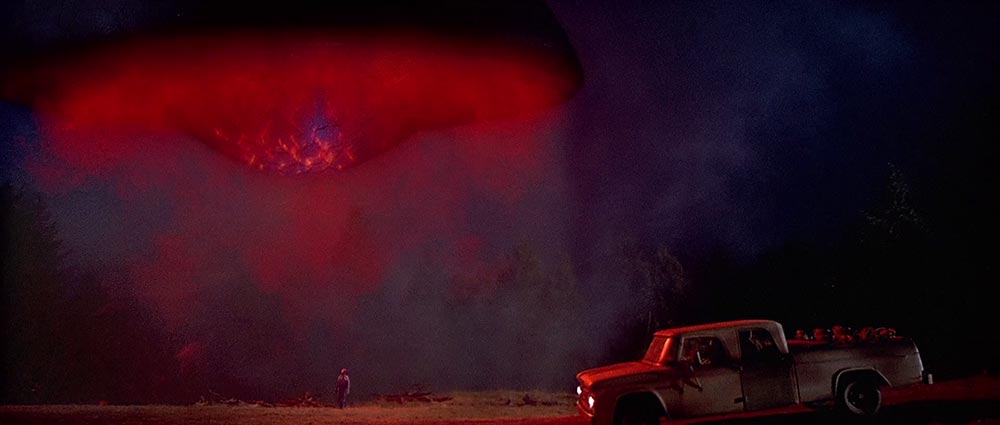Mike Rogers considered Travis Walton his best friend. The two worked together, along with five other local men, as loggers on a contract clearing lesser timber in the Apache-Sitgreaves National Forests. On November 5, 1975, after a long day of work, the party returned to Snowflake, AZ, short one Travis Walton. A five-day search ultimately turned up nothing, though local opinion (including that of Rogers’s wife) remained that the loggers had killed the missing man and successfully hid the evidence—until Walton reappeared, having gone without food or water, unable to recall his whereabouts. Riven by guilt and indignation, Walton and Rogers were estranged for over two years, finally reuniting through forgiveness and the shared trauma that had torn them apart.
That shared sense of trauma, and its effect on the lives of the men involved, is the essential interest of Fire in the Sky (1993). Based on The Walton Experience, Travis’s 1978 retelling of his abduction by UFOs, the film is relatively unconcerned with what actually happened to the 22-year-old logger during his disappearance—until the final 20 minutes. At that point, the compelling, if somewhat defanged, drama of the first hour and a half gives way to a baroque vision of otherworldly horror. Walton awakens in an apparent digestive chamber within a low-gravity ship before being pinned down and tortured by penetrating metal probes in his throat, ears, and one eye, while vaguely humanoid, small-nostriled creatures watch. This short but brutal sequence is the one for which the film is best known. Though it claims to be “based on a true story,” it should be noted that the depicted abduction and experimentation differ wildly from those described in Walton’s book. Screenwriter Tracy Tormé, a writer on the first two seasons of Star Trek: The Next Generation and co-creator of the series Sliders, was asked to “punch up” the encounter by Paramount executives. Apparently Walton’s recollection of bulging-eyed aliens, an unsupervised spaceship control room, and kindly humans in what appeared to be a hospital was too similar to the stories of previous abductees.
Beyond the haunting probing sequence, Fire in the Sky adopts a skeptical position toward its subject from its opening moments. A bright light pierces a misty-evening scene like the beams of a flying saucer, but is revealed to be the headlights of Rogers’s beaten-up pickup truck, and a similar sleight of hand occurs when investigator Watters (James Garner) approaches blinking red lights at a train track crossing moments later. The events of the evening in question, both from Rogers’s perspective and that of Walton, are presented as flashbacks—narrated to the police by the former, and in a violent, intrusive memory that incapacitates the latter. Rather than discussing the shocking events that occurred, the five suspected men are constantly telling each other to “stick to the story” and not “confess,” with the more religious of the party kneeling in a pew and moaning “may God forgive us,” a stained-glass portrait of Jesus gazing into a rather suggestive beam of light in the background. What happened to Walton that night, where was he for the five days that followed, what are his fellow loggers hiding, and how much credibility do we give to his—or any—abduction story?
These are just the sort of needling, delightful questions the film inspires, despite its narrative’s apparent lack of interest. Fire in the Sky’s effectiveness derives not from its treatment of one of the more compelling and foundational UFO abduction stories of the 1970s, nor of the more elemental human mystery it presents—of an unexplained disappearance, or the successful maintenance of a shared lie for nearly four decades. Rather, it serves as a fertile node in a network of proliferating controversies and conspiracies that speak most entertainingly to the film’s 1990s abduction milieu. From a possible reference to the local Sasquatch legends during the manhunt; to the debut just six months later of The X-Files, a show which would star Robert Patrick (here playing Rogers); to the heightened controversy surrounding the use of repressed memory treatment on abductees and the child victims of Satanic cabals at the time of the film’s premiere; to Snowflake’s founding by Mormons and contemporary status as a safe haven for those suffering from Multiple Chemical Sensitivity; Fire in the Sky is an invitation worth taking far beyond its runtime.
Fire in the Sky screens tonight, November 4, and next week, at Anthology Film Archives on 35mm as part of the series “Watch the Skies: Ufology on Screen,” presented by Screen Slate. It will be preceded by Deposition (1993).



